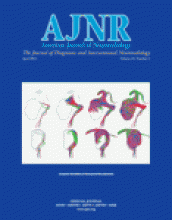Abstract
BACKGROUND AND PURPOSE: Early parenchymal gadolinium enhancement on T1-weighted MR images is predictive of hemorrhagic transformation (HT) in rodent focal ischemia models, but its value in humans is unknown. We sought to investigate gadolinium enhancement in acute ischemic stroke patients to determine their association with subsequent HT.
METHODS: We retrospectively examined 22 patients with ischemic stroke who underwent MR imaging within 4.9 hours (±1.4) of symptom onset. Patients receiving intravenous tissue plasminogen activator (tPA) (n = 6) were included. Twenty-one patients underwent repeat MR studies at 48 hours, 13 underwent additional MR imaging at 1 week, and one underwent follow-up head CT at 24 hours. Initial images were analyzed for enhancement patterns (vascular, meningeal, parenchymal). Follow-up T2- and T2*-weighted images were evaluated for hemorrhage.
RESULTS: In all patients, initial MR images showed vascular enhancement in the vascular territory of the stroke lesion: 19 with vascular enhancement alone and three with vascular and parenchymal enhancement. All three patients with both enhancement patterns had HT: two large and symptomatic, and one asymptomatic (petechial hemorrhage). They received tPA before MR imaging. None of the patients without early parenchymal enhancement developed symptomatic hemorrhage. Six (32%) patients with vascular enhancement alone had petechial hemorrhage at follow-up imaging. In this limited sample, initial mean volumes on diffusion-weighted images, National Institute of Health Stroke Scale scores, and intervals from stroke onset to imaging did not differ between patients with vascular and parenchymal enhancement versus those with vascular enhancement alone.
CONCLUSION: Early parenchymal enhancement of stroke lesions may be a good predictor of subsequent symptomatic HT may help identify patients at risk, especially after thrombolytic therapy.
- Copyright © American Society of Neuroradiology












